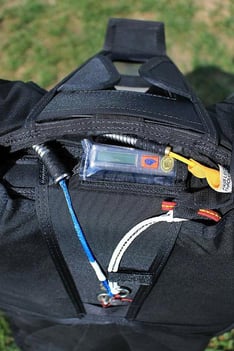Many first-time skydivers are nervous to trust their tandem skydiving instructor and take a leap of faith. We get it. Skydiving can seem scary— but it’s often only intimidating to those who don’t understand just how safe skydiving is.
For many first-time jumpers, their confidence grows when they learn more about their skydiving equipment. That’s why in this post, we’re focusing on how your skydiving parachute works, to educate you on just how foolproof your skydiving gear is.
Overcome your fear and enjoy the best view around by learning about your skydiving equipment.
How Does My Parachute Work?
Your skydiving parachute is stored safely inside of your gear, in a backpack attached to your harness.
The parachute is rectangular-shaped, unlike the old time round chutes of yesterday. This modern style is specially designed to give freefallers more control over their motion and to increase safety.
It extends to form a canopy made up of linked sections or cells. These cells are open from the front, and as your compressed chute is released, they take in a rush of air and expand. Each cell fully inflates and pressurizes to create an airfoil (or wing).
But this is just your main parachute. It often helps to understand that skydivers never leave the plane with just one.
Your Two Parachutes
There’s no need to worry that your parachute won’t deploy, as you’ll be freefalling with not one, but two parachutes. (Plus, they’re both packed by a certified professional to ensure proper deployment!).
A third “parachute” that we use is called a Drogue, which will inflate right after you exit the aircraft. Its job is to regulate your descent to around 120 mph and keep you belly-to-ground.
At 5,000 feet above ground, it’s time to deploy your main parachute. This chute is the large rectangular canopy we described above and helps you get to the ground safely. During almost every freefall, these two parachutes are all you need.
Every skydiving system is also equipped with a reserve parachute, packed neatly in the top portion of the backpack. This back-up canopy is just like the main parachute, waiting in the wings as a precautionary measure.
They’re rarely used, as the modern-day tech of our parachutes is insanely savvy (though each reserve canopy is inspected and repacked every 180 days regardless of if it was deployed!).
The majority time, your trained tandem instructor will know exactly what to do in the event of a malfunction and be able to fix it, but should the reserve be the safer option, it’s a simple switch— so seamless you’ll likely never even realize they used it.
Will My Parachute Automatically Deploy?

Most skydivers will manually deploy their parachutes, however, each system is equipped with a handy device called an Automatic Activation Device (AAD).
Should your tandem skydiving instructor be unable to deploy the parachute, and you forget everything you learned in your pre-jump class (both of which are highly unlikely), your AAD will be there to monitor your altitude and rate of descent.
This device will be programmed to trigger deployment at a set height above ground— and get you to the ground safely.
How Do the Lines Function?
Your parachute is tethered to you with strong parachute lines, which include handles to help you or your tandem partner navigate in the air. These glorified strings work just as you might imagine: they pull on certain parts of your chute to guide your direction.
Pulling the right side of your lines moves your parachute to the right; while pulling left guides you left. If you pull both at the same time (“flaring”), that’ll slow down your descent— since this causes your canopy to reduce its rate of descent.
How Does the Parachute Collapse?
The dreaded landed. Many first-timers are most intimidated by reaching the ground— but luckily your skydiving parachute does wonders in promising a gentle touch down.
Your tandem instructor will know exactly how to flare the chute to encourage a slow and graceful touchdown. These are experienced experts who have performed thousands of safe landings, and will ensure your descent rate is smooth and that your parachute brings you down for a soft landing.
Ready to Try Skydiving?
If after learning about how incredibly safe your skydiving parachute is you still aren’t convinced to try this thrilling activity, we’ve got seven other reasons to take the plunge.
Learn more about your first jump by reviewing our Tandem Skydiving Guide. We have all the best advice for preparing for the big day, right there!


